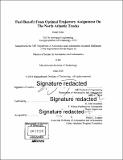Fuel benefit from optimal trajectory assignment on the North Atlantic tracks
Author(s)
Tran, Henry Khoa Massachusetts Institute of Technology
DownloadFull printable version (13.84Mb)
Other Contributors
Massachusetts Institute of Technology. Department of Aeronautics and Astronautics.
Advisor
R. John Hansman.
Terms of use
Metadata
Show full item recordAbstract
The North Atlantic Tracks represent one of the highest density international traffic regions in the world. Due to the lack of high-resolution radar coverage over this region, the tracks are subject to more restrictive operational constraints than flights over the continental U.S. Recent initiatives to increase surveillance over the North Atlantic has motivated studies on the total benefit potential for increased surveillance over the tracks. One of the benefits of increased surveillance is increased accessibility of optimal altitude and speed operations over the track system. For a sample of 4033 flights over 12 days from 2014-2015, a fuel burn analysis was performed that calculates the fuel burn from optimal altitude, optimal speed and optimal track trajectories over the North Atlantic Tracks. These results were compared with calculated as-flown fuel burn in order to determine the benefit potential from optimal trajectories. Operation at optimal altitude and speed increased this benefit to 2.83% reduction potential in average fuel burn. Operation at optimal altitude alone, however, reduces the benefit potential to 1.24% reduction in average fuel burn. Optimal track assignment allows for a 3.20% reduction in average fuel burn. For the sample data, 45.1% of flights were unable to access their optimal altitude and speed due to separation requirements. Reduced separation up to 5 nautical miles can decrease the number of conflicts to 14.0%. Reducing the separation requirements both longitudinally and laterally can allow for increased accessibility of optimal altitudes, speeds and track configurations. Pilot decision support tools that increase awareness of aircraft fuel performance by integrating optimal altitude and speed configurations can also reduce aircraft fuel burn. The utility of such a tool is evaluated through a survey on pilot-decision making.
Description
Thesis: S.M., Massachusetts Institute of Technology, Department of Aeronautics and Astronautics, 2016. Cataloged from PDF version of thesis. Includes bibliographical references (page 63).
Date issued
2016Department
Massachusetts Institute of Technology. Department of Aeronautics and AstronauticsPublisher
Massachusetts Institute of Technology
Keywords
Aeronautics and Astronautics.